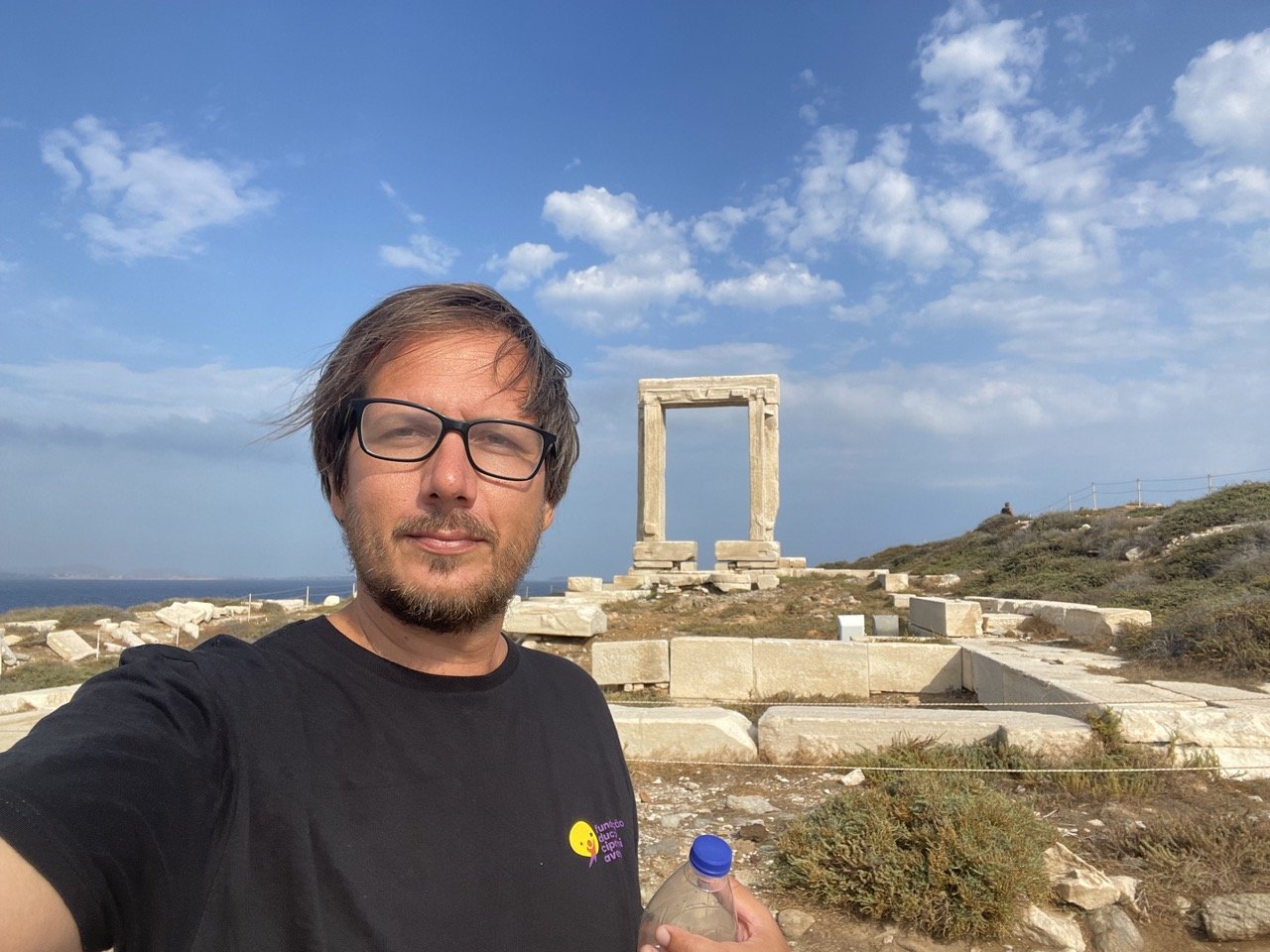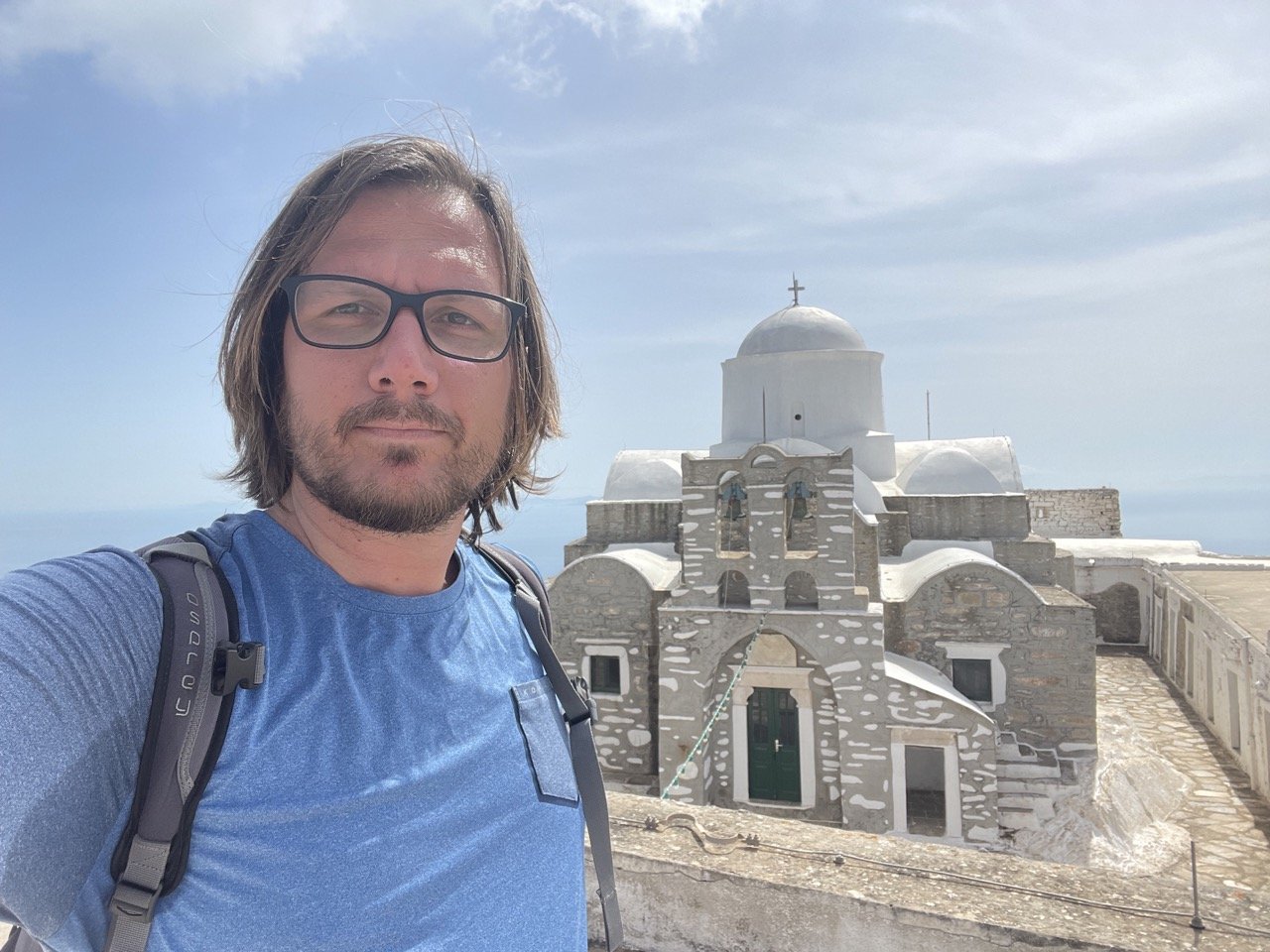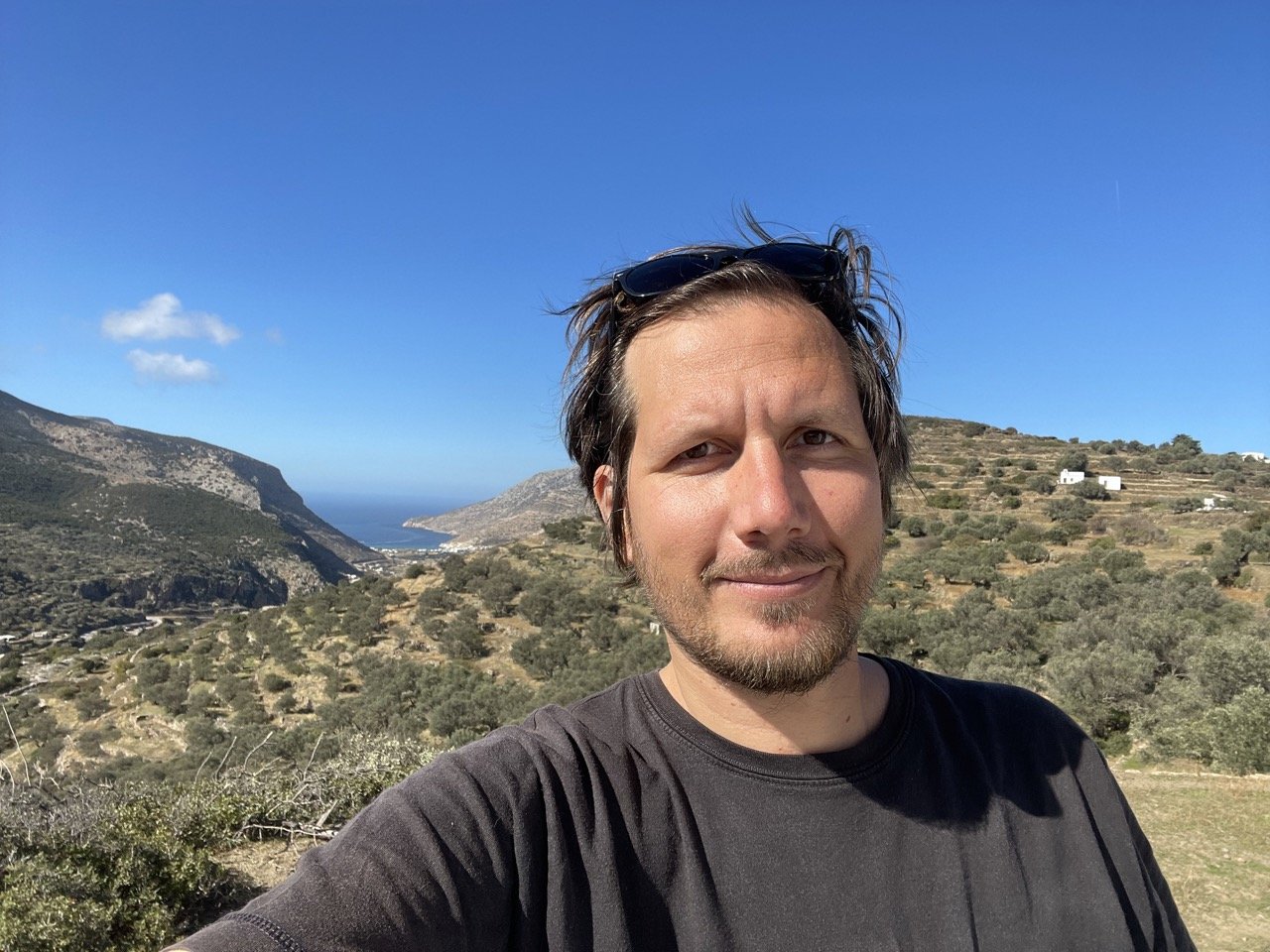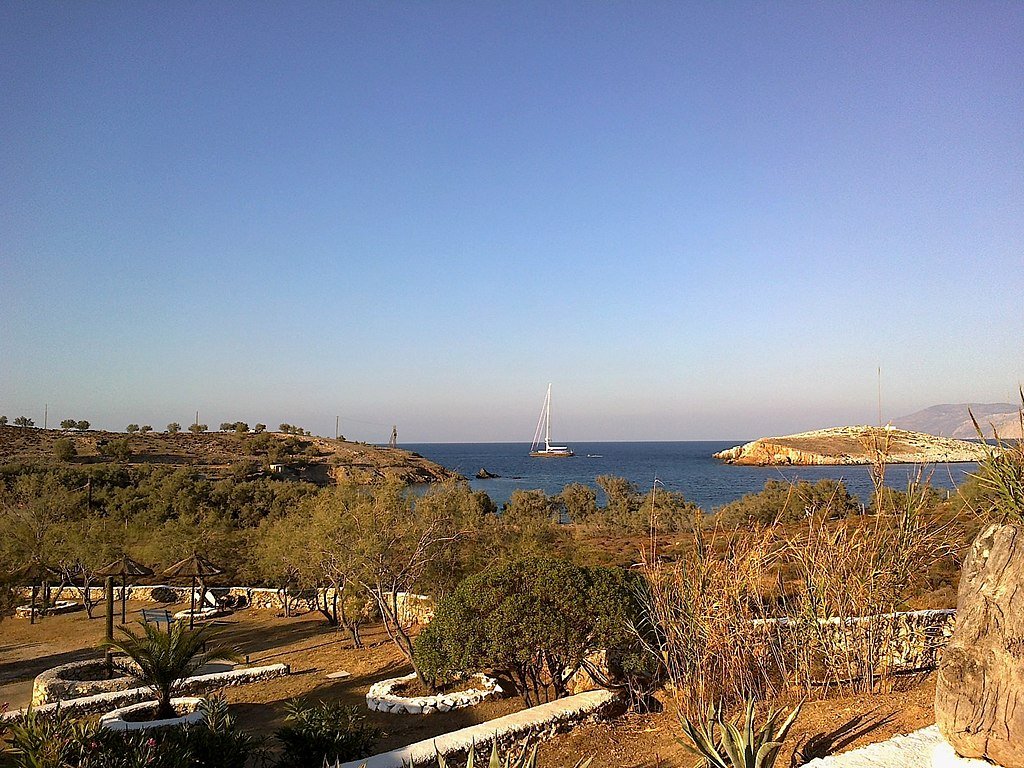A Local’s Guide to Visiting Folegandros, Greece
Affiliate disclosure: some of the links in this article are affiliate links. If you book using one of them, we’ll earn a small commission. All of our info is free to read and free of ads, so we appreciate it!
Folegandros, one of the Cyclades' smallest islands, retains its authenticity and wild beauty despite being nestled right next to world-famous Santorini. Little explored and sparsely developed, the island still holds ancient paths that lead to pristine beaches and quiet corners where you’ll find no one else around.
In the little agricultural village of Ano Meria, you can witness genuine rural life and feel as if transported a world away and into the past.
The island is unspoiled, but not unacustomed to tourism, and its Chora, the main town, is one of the most beatiful in the Cyclades. With a rich tradition and lively atmosphere, it is the perfect town to while away the evenings after days exploring and lounging on the beach.
There aren’t any marquee attractions that would bring you here, but between the stunning landscapes, few but beautiful beaches, lovely center, and peaceful agricultural heartland, Folegandros is a tranquil jewel in the Greek islands.
Table of Contents


Where is Folegandros
Photo: User: Bgabel at wikivoyage shared, CC BY-SA 3.0, via Wikimedia Commons
Folegandros is located in the southern part of the Cyclades island complex, about 100 nautical miles southeast of Athens. The nearest neighboring islands are Milos to the west, Sikinos and Ios to the east, and Santorini to the southeast.
The island covers an area of about 13 square miles and has a year-round population of approximately 750 residents, mainly residing in Chora.
How to get here
Folegandros does not have an airport, so the most common way to get here when coming from mainland Greece is by ferry from Athens. Santorini, which is fairly close to Folegandros, does have an airport though, so you could potentially fly there and then catch a relatively quick ferry over to Folegandros.
By ferry from Athens
There are both conventional and fast ferries that connect Folegandros with Athens’ port of Piraeus. Operated by by Zante Ferries, this service is offered year-round and there are typically 3 to 4 ferries per week, with some variation depending on the season.
The ferry to Folegandros follows a route that also stops at many other islands, including Kythnos, Serifos, Sifnos, Kimolos, Milos, Sikinos, Ios, and Santorini. The price fort a one-way economy ticket starts at approximately 50 euros and the journey takes around 10 hours.
From April to October, Folegandros can also be reached reached by high-speed ferry (operated by Seajets) from Piraeus. The trip takes about 5 hours and costs around 85 euros.
By ferry from other islands
Folegandros is also served year-round by the inter-cycladic route (operated by Hellenic Seaways), which connects islands within the Cyclades to one another. This island ferry travels between Syros, Paros, Naxos, Ios, Sikinos, Folegandros, Kimolos, and Milos and usually runs twice per week.
Where to buy ferry tickets
The main ferry companies serving Folegandros include Seajets, Zante Ferries, and Hellenic Seaways.
To check schedules and prices, I recommend using FerryScanner which is an aggregator that shows options from a bunch of different ferry companies. Their schedules are always up to date, it’s easy to use, and the price difference between using them and booking direct is negligible.
Why visit
The Chora of Folegandros. Photo: / Tinku at Greek Wikipedia, Public domain, via Wikimedia Commons
Folegandros is an island that combines tradition and tourism in a perfectly balanced way. Geographically, it sits between busy and ever-popular Milos and Santorini, so it can easily be combined with one (or both) of those islands and is the perfect contrast to the busy and perhaps crowded days that you’ll have experienced on either of them.
When you’re ready for a dose of tranquility and simplicity, head to Folegandros. The island is well known for its beautiful Chora, which has a charming atmosphere, hospitable and kind inhabitants, and excellent tavernas and cafes.
Built on the edge of a cliff, the town offers unique views of the sea and magnificent sunsets that will impress even the most demanding travelers.
As for the beaches, which are of course a staple of any Greek islands vacation, Folegandros is a bit unique. It’s a very small island, so has a limited coastline, and its topography, which includes many steep cliffs that drop straight into the sea (especially on the eastern side), doesn’t leave much room for sandy beaches.
Despite this, Folegandros has a few beaches and they are truly excellent, with lovely sand and crystal clear waters. Some are easily accessible, while others will require arriving by boat or hiking along trails. In addition to the beaches, there are excellent diving opportunities here.
Considering its small size, the island is also quite easy to move about, and everything is in close proximity, no matter where you are. You will rarely be more than fifteen minutes away from wherever you want to go next.


What is Folegandros known for
As I mentioned above, Folegandros does not have much in the way of premier sights or attractions, and this little island isn’t somewhere you come to check off boxes and spend busy days sightseeing. Rather, it’s a place to relax in blissful surroundings unbothered by masses of other visitors.
As you arrive to Folegandros from the sea, you will be struck by the untamed beauty, and its rugged, harsh nature. This is not somewhere that evokes serene, blissful island life. In antiquity, these features and the difficult living conditions that they created on the island, gave Folegandros its nickname of the "iron" island (σιδερένια).
Despite the challenges of living in amongst a somewhat inhospitable terrain, the people of Folegandros are sweet and kind, they live with simplicity, and warmly welcome visitors to the island, highlighting the concept of Greek hospitality.
Folegandros’ Chora, the principal settlement and capital of the island, is one of the prettiest towns in the Cyclades, with its whitewashed buildings, cobblestone streets, and charming little squares lined up one after the other. The first square is Pounda, followed by Dounavi, Kontarini, Piazza, and Maraki.
Characteristically white, as always in the Cyclades, the monochrome color here is broken by the colorful accents of tall trees and bougainvillea, sprouting from planter pots lining the traditional houses. Surrounding the squares are taverns and restaurants, each painted its own distinct color – a trademark to help them stand out.
Sprouting off from the squares, little cobbled alleys invite you to wander along them aimlessly, stumbling upon beautiful little corners and sights.
Inland, the village of Ano Meria, offers an authentic rural experience, while the town of Agali, is an ideal place for families.
I’ve already mentioned the beaches above, but I will reiterate here that they are are wild and uniquely beautiful. While many are difficult to get to, reachable only by boat or hiking paths, they are worth the effort.
How many days to spend
If you’re looking for somewhere to unwind and just enjoy simple island life, you could easily stay on Folegandros for a week. However, assuming that you plan to visit a few other islands during your trip, 3 days is about the right amount of time to spend here.
The island is small enough that you could visit its main villages and other principal sights in a single busy day, so there’s no real need to plan out an itinerary here. Rather than rushing to fit everything in though, you should prioritize leisurely days with a nice mix of different activities.
Moving between places here is stress-free because everything is so close together, so you can easily enjoy a combination of hikes out to the beaches, boat trips, village visits, and trips into the interior to explore.
I think 3 days is the perfect amount of time to relax and unwind on Folegandros, especially if you’re coming from or heading next to Santorini, Milos, or another busier, more hectic island.
Where to stay
Typical architecture in Folegandros. Photo: Oliwan, CC BY-SA 3.0, via Wikimedia Commons
The best option is to stay is in the centrally located Chora, especially if you don't have transportation. There, you will find a range of accommodations from the simplest to the most luxurious, along with taverns, cafes, and bars.
For those who prefer to be next to the sea, the best options are the port village of Karavostasis or Agkali, a smaller and quieter settlement by the sea.
In the Chora
Folegandros Apartments has lovely accommodation for reasonable summer rates of $150 per night.
Polikandia Hotel offers airy and spacious rooms for a similar price.
In Karavostasis
Onar Suites has gorgeous rooms for around $300 per night.
AMO Folegandros has both regular rooms and apartments for around $150.
In Agkali
Blue Sand is a very pretty boutique hotel with nightly rates around $250.
Pasithea Rooms are really quite nice and moderately priced at around $80 per night.


What to see & do
Sea views near the camping area at Livadi beach. Photo: rene boulay, CC BY-SA 3.0, via Wikimedia Commons
1. Visit the port of Karavostasis
Karavostasis serves as the island's port and is one of its two seaside settlements. It's ideal for those seeking the tranquility of a small traditional island port with easy access to beaches within a 5-minute radius.
From Karavostasis, you can enjoy views of the sunrise, the neighboring Sikinos, and other rocky islets. Boats for tours around the island and to Katergos also depart from here.
2. Experience authentic rural life
Rural life is evident in the settlements of Petousis and Livadi. Livadi, just 5 minutes away from Karavostasis, features a few farmhouses and several cultivated farms, making it one of the most fertile areas on the island. The beach before you arrive is considered one of the best.
3. Meander through Chora
Exploring Chora is a must! Its continuous squares, the Castle, and the well-preserved alleys place Chora of Folegandros among the most beautiful in the Cyclades. The Castle, the oldest part of Chora, dates back to the early 13th century, built to protect the island's inhabitants from pirate raids. It has been continuously inhabited since then, preserving its original character.
The northern side of the castle is built on the edge of the cliff, with many single-roomed houses, some even 500 years old, still inhabited and in good condition. The Castle has two entrances, Paraporti and Lontzia.
4. Visit Panagia Pantanassa church
At the edge of Chora, on a rock 15 minutes from the Primary School in the square of Pounda, stands the lovely Panagia Pantanassa church, with a marvelous courtyard and view. The most famous (and visible!) church on the island, it’s dedicated to the Assumption of the Virgin Mary, and is perched above the village and can be reached by an unmistakable zig-zagging trail.
This is the largest church in Folegandros and was likely built on the site of an ancient temple to Apollo, using materials from its construction. Ancient inscriptions, sculptures, and statue bases are still visible, and a marble inscription from 1687 regarding the temple's renovation has survived.
5. Go back in time in Ano Meria
Leaving the picturesque Chora and heading west, we meet the second large settlement, Ano Meria. It is located along the northwestern edge of the island and has a rural character. Since the mid-19th century, the inhabitants of Ano Meria, mostly farmers, built their houses along the main road.
To this day, houses are scattered on both sides of the road for about two kilometers. The village, with its traditional color that remains indelible over the years, gives its visitors a taste of the past harmoniously tied with the present.
6. Check out the Folklore Museum
Housed in a traditional complex consisting of a main house and outbuildings (storehouse, stable, cellar, threshing floor, wine press, cistern, wine press, "tree house," and oven) from the 19th and early 20th centuries, the Folklore Museum is well worth a visit.
Here, visitors can see everything from the traditional clothing of the Folegandrites to the home decorations of an earlier era. The museum is located near the first houses in Ano Meria.
7. Enjoy the views at the Chapel of Chrysopigi
A very nice spot for views and peace and quiet is the chapel of Chrysopigi at the western end of the island, which you can either drive to or walk to after the end of Ano Meria. Around the chapel is a fairly large open space, and at the edge of it, on the hill, is the Italian watchtower.
8. Visit the Lighthouse of Aspropountas
Another interesting attraction is the Lighthouse of Aspropountas, in Yiofiri, which can be reached on foot either from Livadaki (15 minutes) or from Ano Meria (60 minutes). The lighthouse was built in 1919 at a height of 58 meters above the sea. Its lantern is 11 meters high.
9. Take a boat trip
There’s a 'tour of the island' boat cruise that departs from Karavostasis and runs 3 or 4 times per week, visiting many different beaches. Just be sure to check the schedule while at the port.
10. Sample local delicacies
Folegandros is known for its excellent local products, so be sure to sample them. Some recommendaitos include: handmade pasta matsata, the traditional pita kalasouna made of onion and cheese, the spicy cheese souroto, and the sweet watermelon pie with watermelon; sesame; and honey (and of course, the thyme honey is local and delicious!).
11. Go diving
For those who want to explore the bottoms of the sea surrounding Folegandros, the diving center has all the equipment you need.
12. Hike, hike, and hike some more
For hiking enthusiasts, Folegandros offers a beautiful network of marked paths leading all over the island. From the Mili stop, a 1-hour hike along a pleasant path will take you all the way to the Livadaki coast.
Alternatively, from Ano Meria, there's another path leading to Livadaki beach, requiring about 45 minutes of walking.
Another scenic route includes the path from Chora to Stavros, Christos, Fira, Agali, Ano Meria (St. John the Eleymon), Marmaro, Agios Nikolaos, Galifos, Agali, Chora, Petousis, Livadi, and Karavostasis.
13. Visit a winery
If you like wine, the Paliomylos estate offers the chance to savor local wines against the backdrop of a beautiful sunset.
14. Attend a festival
The festivals and fairs in Folegandros have a special character, and most of them include live music and snacks. If you find yourself on the island during one of these celebrations, such as Easter, Agios Georgios (April 23), Agios Panteleimon (July 26), Panagia (August 14), Stavros (September 13), or Agios Artemios (October 19), be sure to hang around and enjoy the show.
Best beaches
Livadi Beach. Photo: Zde, CC BY-SA 4.0, via Wikimedia Commons
As I’ve said a few times throughout this guide, Folegandros’ beaches are largely untouched by any sort of development. Most of them have sandy or pebbly shores, and they are largely entirely exposed to the sun, with very few offering trees or shade of any kind. Even fewer of them have a taverna.
Some of the beaches are accessible by car, but for others, you’ll have to walk along paths or take one of the boats from the port of Karavostasis (for Katergos beach) or from Agkali (for Agios Nikolaos-Livadaki beach).
Karavostasis is also known for its surrounding beaches. The first one is the beach of Chochlidia, the natural end of the harbor, a favorite destination for families due to its many saltwater beaches.
Additionally, within a 5-minute drive, there is Vardia, another popular beach on the island.
Opposite Karavostasis, on the road to Livadi, you will find the beaches of Latinaki, Poundaki, and Vitsentzou, equally popular destinations for many visitors.
Katergos is a sandy and blue beach, perhaps the most popular among visitors. It can be approached by boat or on foot via a path, which can be covered in half an hour but requires caution and sports shoes.
Livadi, the largest beach of Folegandros, is located at the eastern end of the island and is a small summer settlement near Karavostasis, the island's port. It has a beautiful beach as well as the only organized camping site in Folegandros.
The area, with its many reeds and low vegetation, reminds one of a small plain. From Livadi, you can take the path to Katergos (40').
Agali, in the southern part of the island, is a very popular beach and the newest holiday settlement. Agali and the surrounding beaches (Fira, Galyfos, Agios Nikolaos) are all protected from the strong north-west winds that blow for most of the summer, and so are among the best options for calm water.


How to get around
Folegandros has very little in the way of public transportation, so you should definitely rent a car or motorbike if you want to be able to travel around the island and visit different areas. There is a main road that travels the length of the island, and then a network of smaller roads that splinter off of it, leading to villages, beaches, and other sights.
Renting a car
Faros Rent A Car and Evo Rent A Car are two good local companies, while Donkey Scooters rents out motorbikes.
If you’re planning on renting a car, I also always recommend checking prices on DiscoverCars. It’s an online aggregator that includes offerings from all the major international rental companies as well as lots of smaller local agencies, which often have much better pricing.
Public transport
As for public transportation, there are two buses that operate on a specific schedule, which you can see here. One bus connects Chora with the port of Karavostasis, and the other one connects Chora with the villages of Agali and Ano Meria.
There is also one taxi on the island, which can be reached by phone at +306944693957.
Weather & when to visit
Being a small island with few year-round residents and very little economy outside of tourism, Folegandros almost entirely shuts down during the off season. For visitors, this means that you’re best off coming here from May to September, when the tourist season is in full swing and accommodations and shops are open.
May is an ideal time for hiking, as nature is in full bloom and the weather is pleasantly mild – warm enough for outdoor activities and even dips in the sea, but not too hot that you feel like you need to hide from the midday sun.
June and September offer excellent weather, all services and establishments will be open, the water is a delightful temperature for swimming, and the crowds are quite manageable (these months are before/after it gets super busy).
Easter is also a very nice time to visit, as the island joyously celebrates the holiday and the villagers open up their homes to welcome the image of the Virgin Mary, which is paraded in a procession throughout the town.
July and August are the height of high season. The weather is hottest during this time and any strenuous activities will be pretty unpleasant due to the heat. The crowds are also the biggest during these months and prices for everything are at their peak.
The Folegandros Festivals, which puts on many interesting events, takes place in July though, so this can be a culturally interesting time to visit.


More Greece travel info
For more advice on planning your trip to Greece, have a look at some of our other guides and itineraries!

Connect with Luca












